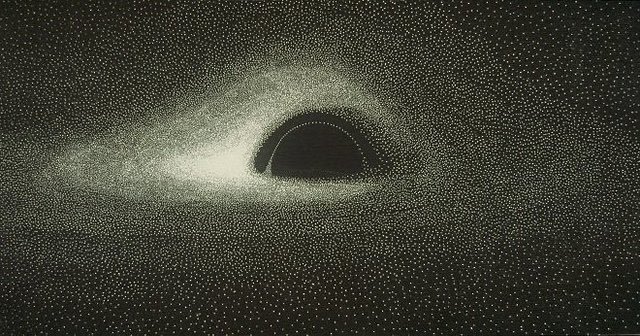
In the vast expanse of the cosmos, black holes have long captivated the imaginations of scientists and the public alike. These celestial enigmas, with their overwhelming gravitational pull and mysterious nature, continue to fascinate us. While the concept of black holes has intrigued researchers for decades, it was not until 1978 that humanity was presented with an extraordinary visual representation of these cosmic phenomena. Jean-Pierre Luminet, armed with punch cards and an IBM 7040 computer, crafted an accurate image that would forever change our understanding of these celestial entities.
It was in 1978 that Jean-Pierre Luminet, an esteemed French astrophysicist, achieved a groundbreaking feat: the creation of the first accurate image of a black hole. Utilizing punch cards, an early form of computer data storage, and an IBM 7040 computer, Luminet embarked on a remarkable journey to visually depict the unfathomable depths of these cosmic behemoths.

Despite the limited technological resources available at the time, Luminet’s pioneering work paved the way for our comprehension of black holes. The resulting image, unveiled to the scientific community, showcased a profound resemblance to the model later featured in the renowned movie ‘Interstellar.’ This striking similarity between Luminet’s depiction and the cinematic representation is a testament to the accuracy and vision behind his creation.
Luminet’s black hole image, painstakingly crafted through meticulous calculations and computer-generated simulations, showcased an iconic silhouette. Its dark center, surrounded by a bright accretion disk, evoked a sense of awe and wonder. Notably, this image closely resembles the real black hole captured in the M87 galaxy, a remarkable achievement considering the technological limitations of the era.
The significance of Luminet’s black hole image extends far beyond its aesthetic appeal. By capturing the attention of scientists and the public, it ignited a newfound interest in the study of black holes and their immense gravitational influence. Luminet’s work provided a visual foundation for subsequent research and helped inspire future generations of astronomers to explore the depths of the universe.
Luminet’s use of punch cards and the IBM 7040 computer underscores the ingenuity required to overcome the technological constraints of the time. In an era before the advent of sophisticated computer graphics, Luminet’s creation demanded a formidable combination of mathematical expertise, computational prowess, and artistic interpretation.

Decades after its creation, Luminet’s black hole image remains a testament to the power of scientific visualization. By bringing the enigmatic world of black holes to life, Luminet kindled a fascination that endures to this day. His work laid the groundwork for subsequent advancements in our understanding of black holes, leading to groundbreaking observations and the eventual capture of real black hole images.
Jean-Pierre Luminet’s pioneering image of a black hole stands as a timeless testament to human curiosity, perseverance, and the boundless nature of scientific exploration. Crafted using punch cards on an IBM 7040 computer, this remarkable creation bears an uncanny resemblance to the black hole depicted in the movie ‘Interstellar’ and even closely mirrors the real black hole captured in M87. Luminet’s work not only transformed our perception of black holes but also fueled our collective drive to unravel the mysteries of the cosmos.

Leave a Reply